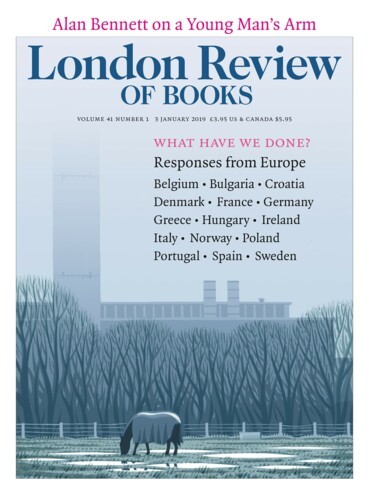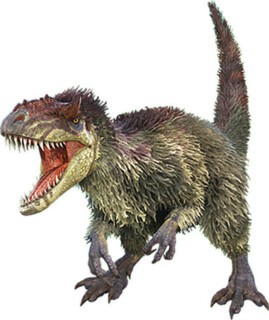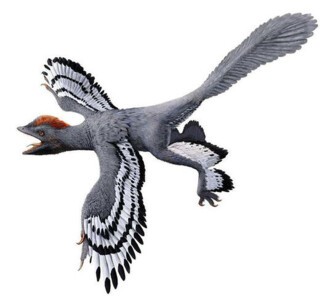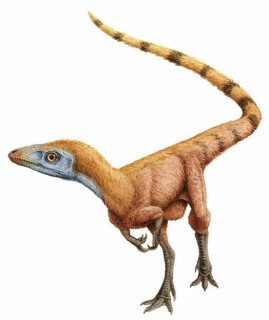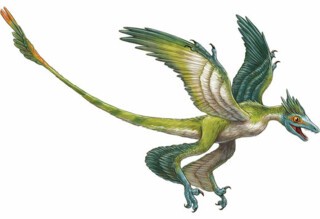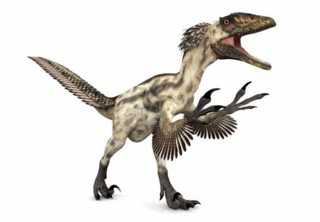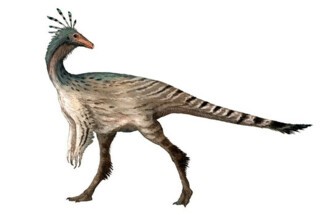‘It was a bad time to be alive,’ Steve Brusatte tells us. A comet or asteroid about six miles across had just collided with the Earth, in the area we know as the Yucatán Peninsula in Mexico. The speed of its arrival compressed the atmosphere ahead of it with such force that air temperatures became hotter than the surface of the sun; the energy released on impact was equivalent to a billion atomic bombs. It smashed through 25 miles of the Earth’s crust, plunging down into the mantle below, leaving a crater a hundred miles wide. Identified in 1991, it has been named the Chicxulub Crater, after the nearest town.
The shockwaves generated global earthquakes of immense magnitude. What had been solid ground rippled and bounced like liquid for thousands of miles. Vast volcanic eruptions were triggered, and giant tsunamis surged across the oceans and far inland. Winds of six hundred miles an hour howled across the planet, and the molten rock thrown up into the atmosphere by the impact rained down in a hail of hot glassy blobs and spears, heating the air as it fell until the forests ignited and living things cooked. All this within the first two hours or so. Soot, dust and smoke filled the atmosphere, eclipsing the sun, and for years afterwards the Earth was cold, dark and bathed in acid rain. This ‘nuclear winter’ was sufficiently severe and long-lasting to halt photosynthesis on land and in the oceans, causing the collapse of those ecosystems that had survived the initial cataclysm. Some 70 per cent of living species were eliminated. Foremost among those that perished were the charismatic, mysterious creatures whose lineage had dominated the planet for well over a hundred million years – the dinosaurs.
Brusatte’s The Rise and Fall of the Dinosaurs is a biography of these magnificent lost beings and their world, and it closes, as it must, with an account of the catastrophe that destroyed them. It could hardly end otherwise; after all, if there is one thing that truly defines the dinosaurs it is that they are all – well, almost all – dead, and no matter how many bones are dug up or how far the science of their lives advances, the climax of the story is always the same. Their certain extinction is a fixed point in a fast-moving field, and it’s the necessary finale to any account of their reign.
The current accepted theory – that an asteroid strike caused the end-Cretaceous mass extinction – was first put forward in 1980 by the geologist Walter Alvarez, working with his father Luis, a physicist and Nobel Prize winner. Brusatte, a reader in vertebrate palaeontology at Edinburgh, describes being taken as a student by Alvarez to a rocky gorge in Perugia near Gubbio, where a band of fine clay running through the limestone marks the place where the geologist had his initial insight. This thin band, now known as the K-Pg boundary, is ‘a bookmark separating the limestones of the Cretaceous below from those of the post-extinction Palaeogene period above,’ Brusatte writes.
It was while looking at these rocks for clues to the formation of Italy and the Alps that Alvarez first became intrigued by the fact that, beyond this marker, all the pages of time’s book seemingly went blank. Below the line was a profusion of diverse fossil shells from the planktonic foraminifera that crowded Cretaceous oceans; above it, almost nothing. And not only did tiny sea creatures disappear at the boundary line, but fossils of larger creatures are absent immediately above it too, both on land and at sea. There are no dinosaurs above it at all: ‘Nothing,’ Brusatte writes, ‘not a single bone or a single footprint anywhere.’ That this boundary marked the end-Cretaceous extinction was already evident to geologists, but what precisely it signified was not known. Alvarez’s key intuition was that the band of clay itself might provide evidence for what sort of event had caused much of life on Earth to vanish 66 million years ago.
With the help of his father, Alvarez had samples of the clay analysed for iridium, a heavy metal that is rarely found on Earth’s surface, but which is common in space, and which falls from the heavens as cosmic dust at a fairly constant rate. The Alvarezes were trying to ascertain how quickly or slowly the band had been deposited. If one assumes the typical pace of accumulation, a large amount of iridium would suggest it had taken a long time, indicating that the extinction process may also have been lengthy; a small amount would suggest that a quick event had overtaken the Earth. But the samples contained a surprise: huge amounts of iridium, so much that it would have taken tens or hundreds of millions of years to deposit at background rates. What could explain it? The Alvarezes came to a radical conclusion: the high concentration of iridium in the band must have come from outer space, and it must have been delivered in bulk by a colossal asteroid strike – an event destructive enough to have triggered the end-Cretaceous extinction. The iridium-rich clay band at Gubbio was the shroud of dust and debris that had eventually settled on a devastated world.
As the same iridium anomaly began to be detected at sites around the world, the Alvarezes’ notion of an asteroid strike followed by the blotting out of the sun was substantiated. It also had an influence beyond palaeontology; when Brusatte describes the aftermath of the impact as being like a nuclear winter, he is gently reverse-engineering the concept, for the idea of a nuclear winter – the darkening and cooling of the world by the dust thrown into the atmosphere after a nuclear exchange – was explored and popularised in the 1980s partly with reference to the Alvarez hypothesis. Meanwhile, the iridium testing and the hypothesis itself came of the Alvarezes’ connections to nuclear science. Luis Alvarez had been a key player in the Manhattan Project, and had helped design ‘Fat Man’, the bomb that was dropped on Nagasaki. ‘He even flew behind the Enola Gay,’ Brusatte notes, ‘to monitor the effects of Little Boy when it was dropped on Hiroshima.’ The accepted theory about the extinction of the dinosaurs is thus intimately connected to a key inventor of the weapons that could bring about a comparable extinction event in the present. Quite aside from the dark poetry of the connection, it seems that in science, no less than in the imagery of palaeoart, dinosaurs frequently appear as an ambiguous proxy for contemporary human concerns.
This slippage seems unavoidable when discussing the extinction of the dinosaurs, and here Brusatte is no different from his predecessors. In reality, nuclear war may be closer than ever, but the threat of it has been superseded by the growing realities of climate change, and so an extinction that was once used as a parable about the devastating consequences of a nuclear conflict has been adapted to address more pressing fears. The end-Cretaceous event proved fatal to most living things, but not all of them. Why did no dinosaurs, large or small, survive it? This is ‘a key question’, Brusatte writes: ‘We want to answer it particularly because it is relevant to our modern world. When there is sudden global environmental and climate change, what lives and what dies?’ In the case of the dinosaurs there are, it seems, two answers.
The first is that they were victims of a kind of bad luck. Several factors, in themselves not disadvantageous under normal conditions, may have told against them under such extreme circumstances. They were large, they were specialised, and their food webs were underpinned by photosynthesising plants. They were energetic and needed huge amounts of food, and they laid eggs which took months to hatch. They could not adapt their diets like an omnivore, hide in a hole like a mouse or lizard, sink to the bottom of a lake like a crocodile, or go into hibernation and not eat for months like a tortoise (creatures like these survived). Brusatte’s more complex analysis of dinosaur diversity suggests that a moderate loss of herbivore species had left key ecosystems – in the regions which are now North America and Europe – slightly more vulnerable to collapse under pressure. When the asteroid struck, ‘dinosaurs were left holding a dead man’s hand.’ And it shouldn’t be forgotten that a majority of all living things, not just dinosaurs, were also eliminated. A billion atom bombs aren’t fussy.
The second response to the question ‘Why did all the dinosaurs die?’ is to contest the premise. We have in fact been thinking about it all wrong: dinosaurs aren’t extinct at all. One important and adaptable group of them is still found everywhere on the planet: birds. ‘Birds,’ Brusatte stresses, ‘are dinosaurs,’ and he is adamant that this should be understood in the literal sense. Looking at a seagull outside his window, he notes that ‘many of the features that allow me to immediately recognise it as a bird are not actually trademarks of birds. They’re attributes of dinosaurs.’ Birds are ‘simply a subgroup of dinosaurs, just like the tyrannosaurs or the sauropods’, he explains, ‘every bit as dinosaurian as T. Rex, Brontosaurus or Triceratops’. The two groups share a common ancestor, making birds just ‘one of the many branches on the dinosaur family tree’.
‘The realisation that birds are dinosaurs is probably the single most important fact ever discovered by dinosaur palaeontologists,’ Brusatte writes. An evolutionary connection between birds and dinosaurs is not in itself a new idea; the 19th-century biologist T.H. Huxley – ‘Darwin’s Bulldog’ – had made a similar observation about Archaeopteryx, the feathered creature whose fossilised remains were first discovered in 1861. This was the first evidence of feathers in the prehistoric record, and being very bird-like but clearly not a true bird, Archaeopteryx was hailed by Darwin himself as an example of a transitional fossil – one of the hallowed ‘missing links’ between different species that were implied by the idea of evolution through natural selection. But Huxley, a comparative anatomist, noted that the skeleton was strikingly similar to that of Compsognathus, a small carnivorous theropod (the same sub-order that contains tyrannosaurs and Velociraptor), whose fossils could be found in the same geological formation as Archaeopteryx. Going further than Darwin, he suggested that birds were in fact the descendants of dinosaurs.
The issue remained thorny for a hundred years. New discoveries and arguments during the 20th century periodically boosted the case, with the discovery in 1969 of the mobile, bird-like predator Deinonychus eventually ushering in a new consensus that birds had indeed most likely evolved from dinosaurs, as Huxley had thought. Even then there was one particular sticking point: though it might be inferred that defining bird characteristics – feathers and flight especially – must have had precursors in their dinosaur forebears, the fossil record was silent. There was Archaeopteryx, and there was a lot of circumstantial anatomical evidence, but there was no fossil of a feathered dinosaur.
That changed in 1996, with a series of discoveries from fossil beds in the Liaoning region of north-eastern China. The environment at Liaoning in the early Cretaceous was one of dense forests and lakes, with a diverse ecology of dinosaurs, birds, mammals and other creatures. It was also volcanic, and entire areas were occasionally destroyed by eruptions that buried the ancient Liaoning countryside in layers of volcanic ash, preserving unlucky local creatures in miraculous detail. In this prehistoric Pompeii, a feathered dinosaur was finally discovered. (A curious correspondence between geopolitical ascendancy and palaeontological advance can be observed here. During the imperial, industrial 19th century, England was the principal scene of discoveries and advances in the field. In the 20th, the mantle was passed to the United States; so far in the 21st, the site of the most dramatic finds is China. Success in the present is reinforced and naturalised by autochthonous possession of the most important prehistoric relics.)
The feathered fossil creature was named Sinosauropteryx (‘Chinese reptile wing’) – a small, carnivorous theropod about a metre long, covered in a fuzz of thin filaments. Some years later, these primitive feathers were the first dinosaur tissues to undergo successful analysis for traces of their original coloration, as scientists discovered melanosomes, tiny capsules that contain pigment, in some well-preserved fossils. The shape of these melanosomes reveals the colour they once held, and the perennial question of dinosaur colour could in this case be answered: the fuzzy, birdlike Sinosauropteryx was ginger, with white and ginger bands along the length of a long, fluffy tail.
The gravity and value of such discoveries were quickly understood. The farmers and prospectors who knew the land at Liaoning wasted no time in making more of them; the area has since yielded dozens upon dozens of feathered dinosaurs in all shapes and sizes. A whole series of creatures from successive prehistoric ecologies have been found, and they have shown that feathers and bird-like anatomical features were common to a large group of dinosaurs. Some have body designs seen nowhere else, such as the bizarre Microraptor, all four of whose limbs were feathered wings (the same analysis that was used on Sinosauropteryx indicates that its feathers were the iridescent black of a starling). Other discoveries have changed the way we imagine well-known dinosaurs: the fluffy coat of feathers that covered Yutyrannus, a large tyrannosaur of the early Cretaceous, suggest strongly that its later, more famous relative T. Rex would also have had at least some feathering.
The fossils from Liaoning are extraordinary in providing what Brusatte describes as ‘an almost perfect case study’ of a major evolutionary transition. The striking range of creatures preserved helps to ‘untangle one of the biggest riddles of biology: how evolution produces radically new groups of organisms, with restyled bodies capable of remarkable new behaviours’. Such long-term changes cannot be simulated or observed; only fossils can provide evidence for the way organisms changed over long periods of time in the deep past. Archaeopteryx may have been a missing link, but Liaoning was the reliquary for a whole lost chain. The discoveries were so extensive that, ‘when stitched together and placed on a family tree, they provide something of a running film of an evolutionary transition in action.’ Most significant, ‘the Liaoning fossils confirm where birds perch on the dinosaur family tree. Birds are a type of theropod’ – exactly as Huxley had suggested.
The discoveries also tell us something about the development of feathers themselves, because although some of the creatures could clearly take to the air or at least glide, most of these feathered dinosaurs could not fly. In Sinosauropteryx and many other small feathery dinosaurs, the feathers were very simple, more a fluffy, fur-like covering. The creatures themselves were ground-dwelling, and mostly without anything wing-like. Perhaps their ‘proto-feathers’ developed to keep them warm; perhaps they were used for display, or camouflage. Some dinosaurs would develop more complex feathers, of the kind we see in modern birds, but not all of them flew either. Moreover, it seems that wings themselves did not originate as a means of flight. The first feathered dinosaur discovered in the US – a large, ostrich-like ornithomimosaur, sporting ‘a mange of cotton-candy fuzz’ – has what are, anatomically speaking, feathered wings; but like those of a modern ostrich, they could not possibly have been used for flying. The creature was too large – as big as a horse – and its wings far too small. No one knows what purpose such wings served, or why they developed; to judge from modern birds, display is one possibility.
The anatomical link with birds also provides insight into the most baffling aspect of dinosaur biology: their enormous size. The biggest of them, a late Cretaceous group of Diplodocus-like sauropods named titanosaurs, were the largest land-dwelling animals since life began, and by a very large margin. Felicitously named creatures such as Dreadnoughtus, Austroposeidon and Patagotitan could grow to around thirty metres in length and weigh more than fifty tons – for scale, Brusatte notes that this is ‘more than a Boeing 737’. Such beings seem to have slipped the bonds that govern terrestrial growth and size. How could they function?
There are various factors at work, but part of the answer to the problem of dinosaur gigantism seems to be that they had unusually efficient lungs, which worked on the same design found in birds. The lungs of a bird are ‘unidirectional’ – they do not work like a bellows, but circulate air in one direction, thanks to a complex arrangement involving a series of air sacs that extend into special cavities in the bones. This means that birds can extract oxygen from air on inhalation and exhalation – ‘twice the bang for the buck, a continuous supply of energy-sustaining oxygen’. The fossil bones of some large dinosaurs show similar cavities, which are called pneumatic fenestrae: ‘They are exactly the same structures as in modern birds, and they can only be made by air sacs,’ Brusatte explains. They also made the skeleton lighter. In fact, the bones of some large sauropods ‘were little more than honeycombs, featherweight but still strong’, hollowed out by the elaboration of ‘ultra-efficient lungs that could take in enough oxygen to stoke their metabolism at huge size’. Beyond birds and some dinosaurs, no other animals have the same design. Its unique efficiency seems to have helped sauropods to grow into giants, giving a T. Rex the bursts of energy needed to strike its prey from ambush and bite down with a force of three thousand pounds per tooth; today, the design makes it possible for modern birds to fly enormous distances in freezing and rarefied air.
Perhaps just such a skill was key in helping a small number of the dinosaurs we call birds survive when the fire and darkness of the end-Cretaceous asteroid strike overtook life on Earth. Their descendants are intelligent, adaptable and mobile. They have evolved, in dazzling variety, to endure and thrive in all climates and habitats on Earth. From the Antarctic to the Sahara to the open ocean, they populate every corner of the globe. No doubt some hardy creatures will ride out the current planetary catastrophe, and birds are as good a contender as any; after all, 66 million years ago they had what it took to evade the effects of a billion atom bombs. So maybe the dinosaurs will survive the sixth mass extinction too.
Send Letters To:
The Editor
London Review of Books,
28 Little Russell Street
London, WC1A 2HN
letters@lrb.co.uk
Please include name, address, and a telephone number.
